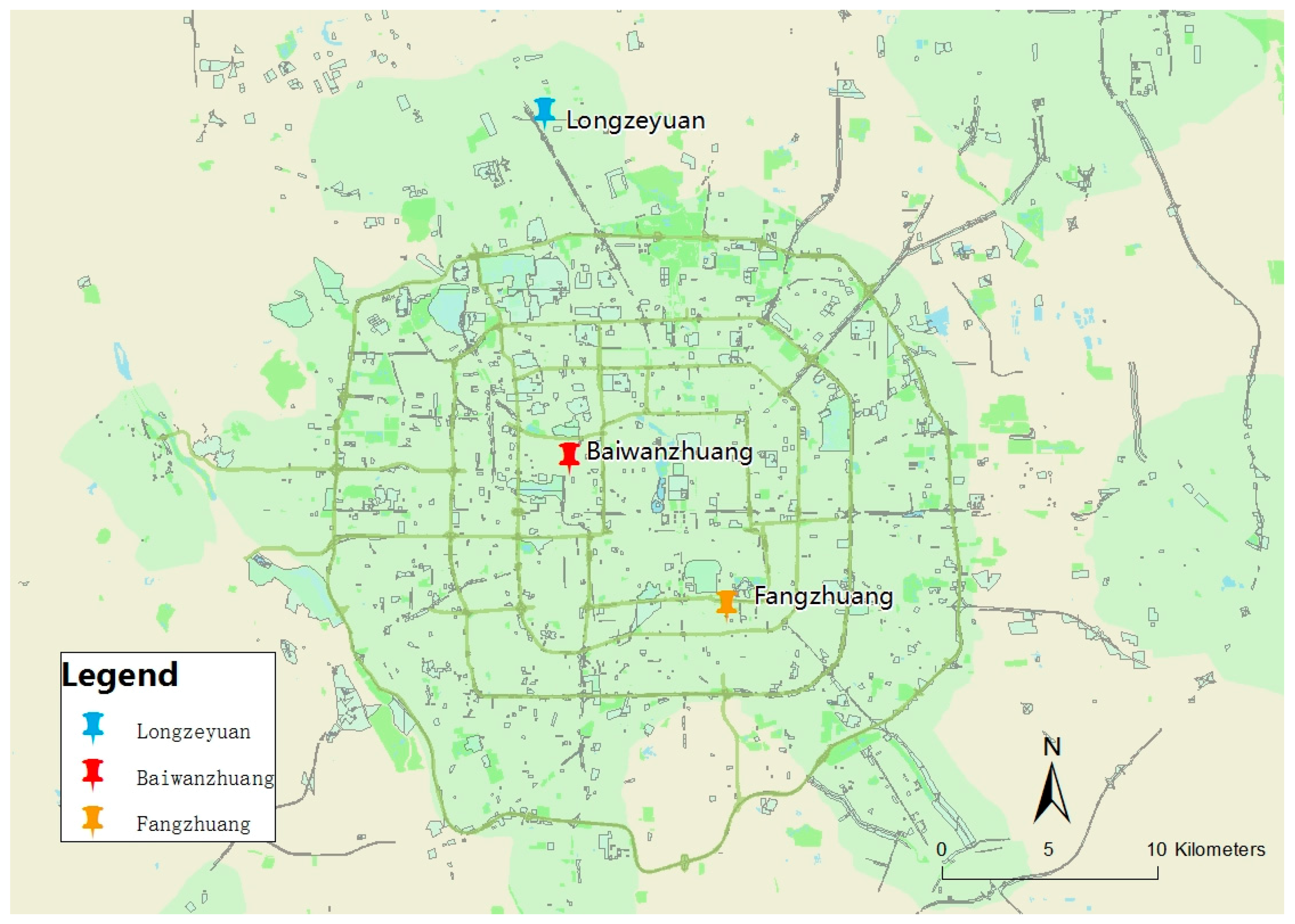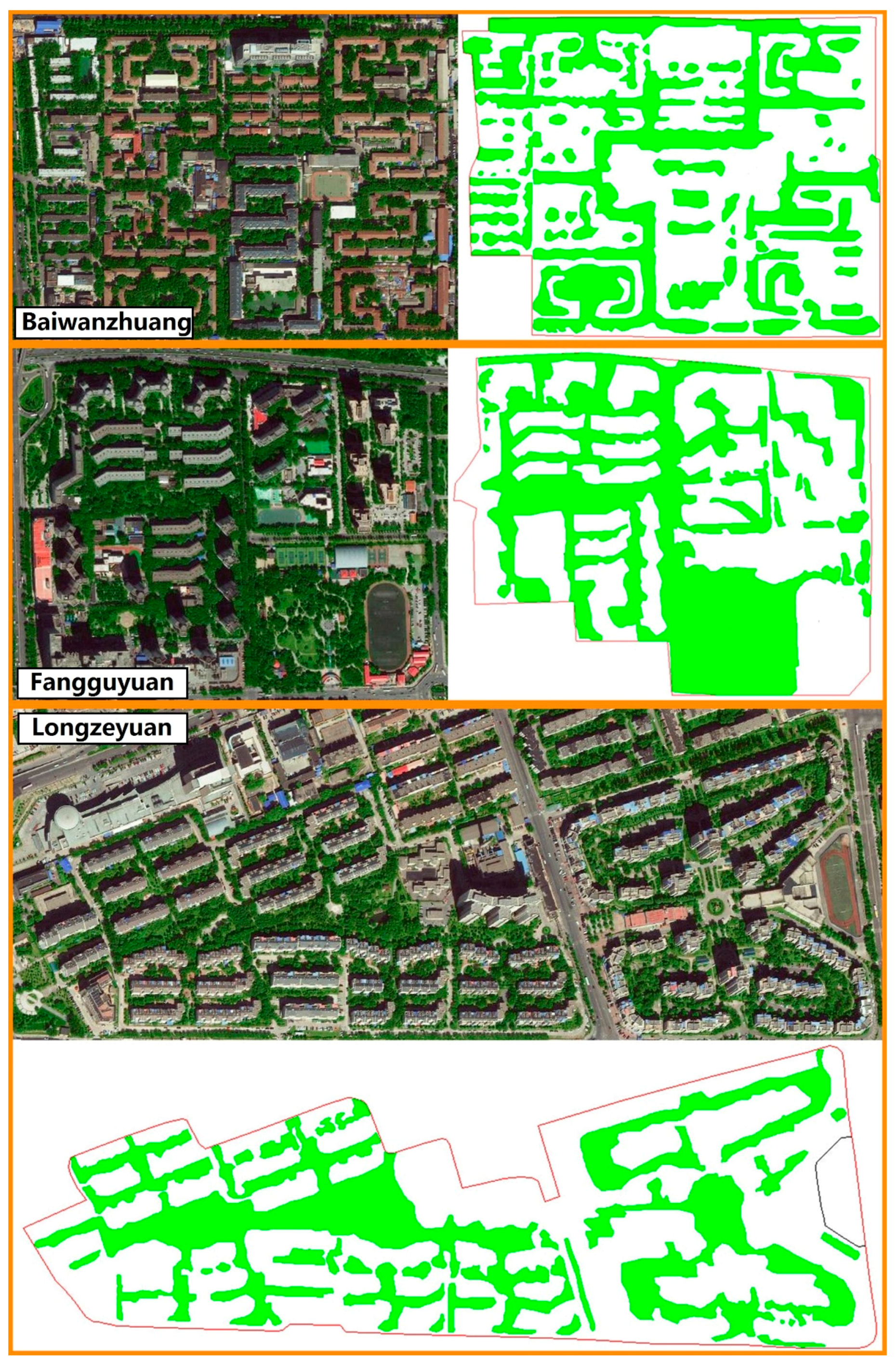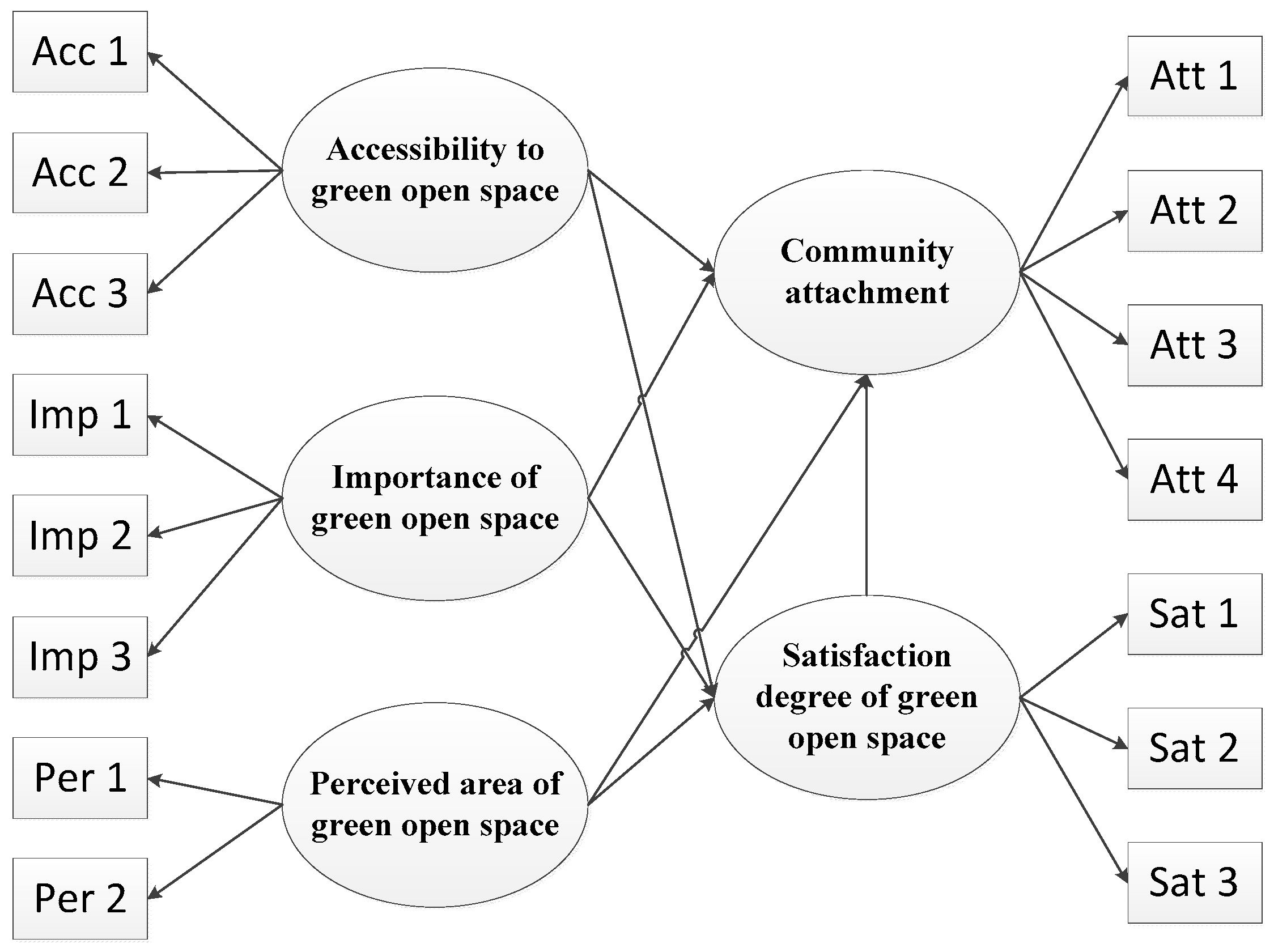The Impact of Green Open Space on Community Attachment—A Case Study of Three Communities in Beijing
Abstract
:1. Introduction
2. Materials and Methods
2.1. Materials
2.2. Methods
2.2.1. Questionnaire Survey
2.2.2. Hierarchical Regression Analysis
2.2.3. Structural Equation Model
2.2.4. Land Shape Index
3. Results
3.1. Effects of Green Open Space on Community Attachment
3.2. Effects of Green Open Space Layout on Community Attachment
3.3. Impact Path of Green Open Space on Community Attachment
4. Discussion
5. Conclusions
Acknowledgments
Author Contributions
Conflicts of Interest
References
- Maslow, A.H. A theory of human motivation. Psychol. Rev. 1943, 50, 370. [Google Scholar] [CrossRef]
- Ellin, N. Postmodern Urbanism; Princeton Architectural Press: New York, NY, USA, 1999. [Google Scholar]
- Kallus, R.; Law-Yone, H. Neighborhood—The metamorphosis of an idea. J. Archit. Plan. Res. 1997, 14, 107–125. [Google Scholar]
- Cross, J. Conceptualizing Community Attachment. In Proceedings of the Rural Sociological Society Annual Meeting, Montreal, QC, Canada, 27–30 July 2003. [Google Scholar]
- Hummon, D.M. Community Attachment: Local Sentiment and Sense of Place; SpringLink: Berlin, Germany, 1992. [Google Scholar]
- McCool, S.F.; Martin, S.R. Community attachment and attitudes toward tourism development. J. Travel Res. 1994, 32, 29–34. [Google Scholar] [CrossRef]
- Ma, X. Sense of belonging to school: Can schools make a difference? J. Educ. Res. 2003, 96, 340–349. [Google Scholar] [CrossRef]
- Hagerty, B.M.; Williams, R.A.; Coyne, J.C.; Early, M.R. Sense of belonging and indicators of social and psychological functioning. Arch. Psychiatr. Nurs. 1996, 10, 235–244. [Google Scholar] [CrossRef]
- McMillan, D.W.; Chavis, D.M. Sense of community: A definition and theory. J. Community Psychol. 1986, 14, 6–23. [Google Scholar] [CrossRef]
- Grobecker, P.A. A sense of belonging and perceived stress among baccalaureate nursing students in clinical placements. Nurse Educ. Today 2016, 36, 178–183. [Google Scholar] [CrossRef] [PubMed]
- Jun, W. The Coming of Individualized Society and the Construction of Social Inclusion Policies. J. Soc. Sci. 2012, 1, 014. [Google Scholar]
- Li, W.; Lei, G. Definition of Community and Identity Construction in Community. Urban Dev. Stud. 2013, 20, 78–82. [Google Scholar]
- Zhao, M. A Discussion on Community Building and Community Preference in City Planning. Planners 2013, 29, 5–10. [Google Scholar]
- Huang, Y. Community Integration: An Important Aspect of Social Integration. Henan Soc. Sci. 1997, 4, 71–74. [Google Scholar]
- Yang, D. New Community and New City: The Disappearance of Residential District and the Rise of New Community; China Electric Power Press: Beijing, China, 2006. [Google Scholar]
- Cornwell, E.Y.; Waite, L.J. Social disconnectedness, perceived isolation, and health among older adults. J. Health Soc. Behav. 2009, 50, 31–48. [Google Scholar] [CrossRef] [PubMed]
- Newman, B.M.; Lohman, B.J.; Newman, P.R. Peer group membership and a sense of belonging: Their relationship to adolescent behavior problems. Adolescence 2007, 42, 241. [Google Scholar] [PubMed]
- Chang, H.S.; Chen, T.L. Decision making on allocating urban green spaces based upon spatially-varying relationships between urban green spaces and urban compaction degree. Sustainability 2015, 7, 13399–13415. [Google Scholar] [CrossRef]
- Littke, H. Planning the Green Walkable City: Conceptualizing Values and Conflicts for Urban Green Space Strategies in Stockholm. Sustainability 2015, 7, 11306–11320. [Google Scholar] [CrossRef]
- Mitchell, R.; Popham, F. Effect of exposure to natural environment on health inequalities: An observational population study. Lancet 2008, 372, 1655–1660. [Google Scholar] [CrossRef]
- Chen, Y.; Liu, T.; Xie, X.; Marušić, B.G. What attracts people to visit community open spaces? A case study of the Overseas Chinese Town community in Shenzhen, China. Int. J. Environ. Res. Public Health 2016, 13, 644. [Google Scholar] [CrossRef] [PubMed]
- Xue, F.; Gou, Z.; Lau, S.S.Y. Human Factors in Green Office Building Design: The Impact of Workplace Green Features on Health Perceptions in High-Rise High-Density Asian Cities. Sustainability 2016, 8, 1095. [Google Scholar] [CrossRef]
- Ulrich, R.S. Natural versus urban scenes some psychophysiological effects. Environ. Behav. 1981, 13, 523–556. [Google Scholar] [CrossRef]
- Dinnie, E.; Brown, K.M.; Morris, S. Reprint of “Community, cooperation and conflict: Negotiating the social well-being benefits of urban greenspace experiences”. Landsc. Urban Plan. 2013, 118, 103–111. [Google Scholar] [CrossRef]
- Bow, V.; Buys, L. Sense of Community and Place Attachment: The Natural Environment Plays a Vital Role in Developing a Sense of Community. Presented at the Social Change in the 21st Century Conference. 2003. Available online: http://eprints.qut.edu.au/115/1/Bow%26Buys.pdf (accessed on 21 November 2003).
- Ward Thompson, C.; Aspinall, P.; Roe, J.; Robertson, L.; Miller, D. Mitigating Stress and Supporting Health in Deprived Urban Communities: The Importance of Green Space and the Social Environment. Int. J. Environ. Res. Public Health 2016, 13, 440. [Google Scholar] [CrossRef] [PubMed]
- Lu, M. Determinants of residential satisfaction: Ordered logit vs. regression models. Growth Chang. 1999, 30, 264–287. [Google Scholar] [CrossRef]
- Speare, A. Residential satisfaction as an intervening variable in residential mobility. Demography 1974, 11, 173–188. [Google Scholar] [CrossRef] [PubMed]
- Goudy, W.J. Community Attachment in a Rural Region. Rural Sociol. 1990, 55, 178–198. [Google Scholar] [CrossRef]
- Kasarda, J.D.; Janowitz, M. Community attachment in mass society. Am. Sociol. Rev. 1974, 39, 328–339. [Google Scholar] [CrossRef]
- Turner, T. Landscape Planning; Hutchinson Education: London, UK, 1987. [Google Scholar]
- Weijters, B.; Baumgartner, H.; Geuens, M. The Calibrated Sigma Method: An Efficient Remedy for Between-Group Differences in Response Category Use on Likert Scales. Int. J. Res. Mark. 2016, 33, 944–960. [Google Scholar] [CrossRef]
- Wei, M.; Heppner, P.P.; Mallinckrodt, B. Perceived coping as a mediator between attachment and psychological distress: A structural equation modeling approach. J. Couns. Psychol. 2003, 50, 438. [Google Scholar] [CrossRef]
- Homer, P.M.; Kahle, L.R. A structural equation test of the value-attitude-behavior hierarchy. J. Personal. Soc. Psychol. 1988, 54, 638. [Google Scholar] [CrossRef]
- Moser, D.; Zechmeister, H.G.; Plutzar, C.; Sauberer, N.; Wrbka, T.; Grabherr, G. Landscape patch shape complexity as an effective measure for plant species richness in rural landscapes. Landsc. Ecol. 2002, 17, 657–669. [Google Scholar] [CrossRef]
- Cronbach, L.J. Coefficient alpha and the internal structure of tests. Psychometrika 1951, 16, 297–334. [Google Scholar] [CrossRef]
- Hau, K.-T.; Wen, Z.; Cheng, Z. Structural Equation Model and Its Application; Education Science Press: Beijing, China, 2004; pp. 1–3. [Google Scholar]
- Salleh, A.G. Neighborhood factors in private low-cost housing in Malaysia. Habitat Int. 2008, 32, 485–493. [Google Scholar] [CrossRef]
- Coley, R.L.; Sullivan, W.C.; Kuo, F.E. Where does community grow? The social context created by nature in urban public housing. Environ. Behav. 1997, 29, 468–494. [Google Scholar] [CrossRef]
- Loures, L.; Santos, R.; Panagopoulos, T. Urban parks and sustainable city planning-The case of Portimão, Portugal. Population 2007, 15, 23. [Google Scholar]
- Gerson, K.; Stueve, C.A.; Fischer, C.S. Attachment to place. In Networks and Places: Social Relations in the Urban Settin; Free Press: New York, NY, USA, 1977; pp. 139–161. [Google Scholar]
- Ladewig, H.; McCann, G.C. Community satisfaction: Theory and measurement. Rural Sociol. 1980, 45, 110. [Google Scholar]
- Potter, J.; Cantarero, R. How does increasing population and diversity affect resident satisfaction? A small community case study. Environ. Behav. 2006, 38, 605–625. [Google Scholar] [CrossRef]
- Connerly, C.E.; Marans, R.W. Comparing two global measures of perceived neighborhood quality. Soc. Indic. Res. 1985, 17, 29–47. [Google Scholar] [CrossRef]
- Coombes, E.; Jones, A.P.; Hillsdon, M. The relationship of physical activity and overweight to objectively measured green space accessibility and use. Soc. Sci. Med. 2010, 70, 816–822. [Google Scholar] [CrossRef] [PubMed]
- Wang, L. Community Social Capital and the Formation of Community Attachment. Truth Seek. 2006, 9, 48–50. [Google Scholar]
- Kim, D.J. An investigation of the effect of online consumer trust on expectation, satisfaction, and post-expectation. Inf. Syst. e-Bus. Manag. 2012, 10, 219–240. [Google Scholar] [CrossRef]
- Schultz, W.; Dayan, P.; Montague, P.R. A neural substrate of prediction and reward. Science 1997, 275, 1593–1599. [Google Scholar] [CrossRef] [PubMed]
- Galster, G.C.; Hesser, G.W. Residential satisfaction compositional and contextual correlates. Environ. Behav. 1981, 13, 735–758. [Google Scholar] [CrossRef]




| Structural Variable | Measurement Index | |||
|---|---|---|---|---|
| Accessibility to green open space | Recreational sites are often visited | Recreational sites are very convenient | Most recreational sites are known | |
| Importance of green open space | Green open space play an important role in adjusting the climate in the community | Green open space improve life quality | Green open space is very important to life | |
| Perceived area of green open space | Expect more green open space in the community | Community needs more green open space | ||
| Satisfaction degree of green open space | Whole satisfaction value to the park | Whole satisfaction value to the square | Whole satisfaction value to the green open space | |
| Community attachment | I do not want to live in other communities | I have a strong community attachment | The community is special to me | I will be very sad when I leave |
| Characteristics | Classification | Total (%) | Baiwanzhuang (%) | Fangguyuan (%) | Longzeyuan (%) |
|---|---|---|---|---|---|
| Gender | Male | 42.4 | 37.8 | 47.7 | 40.3 |
| Female | 57.6 | 62.2 | 52.3 | 59.7 | |
| Age | Aged Under 18 | 2 | 1.8 | 1.9 | 2.1 |
| Aged 18–65 | 79.5 | 58.6 | 88.4 | 86.1 | |
| Aged 65 and over | 18.5 | 39.6 | 9.7 | 11.8 | |
| Marital status | Married | 88.5 | 93.7 | 84.5 | 88.9 |
| Unmarried | 10 | 2.7 | 14.8 | 10.4 | |
| Divorced, widowed or others | 1.5 | 3.6 | 0.6 | 0.7 | |
| Length of residence time | Less than 1 year | 11 | 4.5 | 10.3 | 16.7 |
| 1–5 years | 24.1 | 12.6 | 28.4 | 28.5 | |
| 6–10 years | 17.3 | 5.4 | 16.8 | 27.1 | |
| More than 10 years | 47.6 | 77.5 | 44.5 | 27.8 | |
| Beijing hukou status | Local residents | 63.9 | 86.5 | 69.0 | 41.0 |
| Migrants | 36.1 | 13.5 | 31.0 | 59.0 | |
| Monthly income | Less than 3000 yuan | 25.6 | 34.2 | 26.5 | 18.1 |
| 3000–5000 yuan | 25.9 | 32.4 | 31.0 | 15.3 | |
| 5000–7000 yuan | 25.6 | 25.2 | 27.7 | 23.6 | |
| More than 7000 yuan | 22.9 | 8.1 | 14.8 | 43.1 | |
| Education level | Junior middle school and below | 18 | 26.1 | 21.9 | 7.6 |
| Senior middle school or junior college | 35.6 | 45.9 | 34.2 | 29.2 | |
| University | 34.9 | 24.3 | 33.5 | 44.4 | |
| Master and above | 11.5 | 3.6 | 10.3 | 18.8 | |
| Employment | Housewife | 7.8 | 10.8 | 6.5 | 6.9 |
| Student | 1.7 | 0.9 | 1.9 | 2.1 | |
| Retiree | 36.1 | 62.2 | 27.1 | 25.7 | |
| Employed | 23.4 | 11.7 | 27.7 | 27.8 | |
| Self-employed | 31 | 14.4 | 36.8 | 37.5 |
| Total | Baiwanzhuang | Fangguyuan | Longzeyuan | |||||
|---|---|---|---|---|---|---|---|---|
| Items | Step 1 | Step 2 | Step 1 | Step 2 | Step 1 | Step 2 | Step 1 | Step 2 |
| Control variable | ||||||||
| Residence time | 6.599 *** | 9.445 *** | 3.817 *** | 4.173 *** | 1.758 | 2.989 | 0.475 | 1.282 |
| Expected residence time | 6.366 *** | 6.589 *** | 4.130 *** | 4.671 *** | 4.244 *** | 3.716 *** | 4.130 *** | 4.680 *** |
| Beijing hukou status | −0.262 | 0.121 | −2.162 * | −1.702 | 0.567 | −1.118 | −0.969 | −1.072 |
| Income level | −1.481 | −2.355 | −3.418 *** | −3.794 *** | −1.293 | −0.643 | 0.151 | 0.529 |
| Occupation | −2.465 * | −3.345 *** | 0.337 | −0.416 | −0.662 | −0.872 | −1.976 | −1.276 |
| Educational level | −1.404 | −2.863 | −1.358 | −1.812 | −2.445 * | −3.885 *** | 0.725 | 1.628 |
| Satisfaction with green open space | ||||||||
| Overall satisfaction value of community park | -- | −0.275 | -- | 2.186 * | -- | 0.245 | 1.255 | |
| Overall satisfaction value of community square | -- | 4.532 *** | -- | 1.186 | -- | 4.485 *** | -- | 5.564 *** |
| Overall satisfaction value of green open space | -- | 3.543 *** | -- | 2.477 * | -- | 0.851 | -- | 1.572 |
| Accessibility to green open space | ||||||||
| Often going to the recreational sites in green open space | -- | 1.910 | -- | 1.356 | -- | 2.334 * | -- | 3.305 *** |
| Knowing most recreational sites in green open space | -- | 1.725 | -- | 0.692 | -- | 0.651 | -- | 0.454 |
| Importance of green open space | ||||||||
| Green open space improve life quality | -- | 4.035 *** | -- | −0.025 | -- | 5.163 *** | -- | 1.894 |
| Green open space is very important for life | -- | −0.208 | -- | 2.034 * | -- | −0.769 | -- | 0.201 |
| Perceived area of green open space | ||||||||
| Expecting more green open space in their community | -- | 2.451 * | -- | 2.772 ** | -- | 0.483 | -- | −0.631 |
| (Constant) | −5.005 *** | −9.940 *** | −1.140 | −4.746 *** | −1.572 | −6.827 *** | −3.872 *** | −8.857 *** |
| R2 | 0.272 | 0.438 | 0.407 | 0.582 | 0.152 | 0.406 | 0.107 | 0.432 |
| R2adj | 0.267 | 0.428 | 0.384 | 0.549 | 0.141 | 0.386 | 0.101 | 0.420 |
| F-value | 50.615 *** | 44.729 *** | 18.171 *** | 17.746 *** | 13.608 *** | 20.330 *** | 17.053 *** | 35.468 *** |
| Totality | Baiwanzhuang | Fangguyuan | Longzeyuan | |
|---|---|---|---|---|
| R2adj (Step 1) | 0.267 | 0.384 | 0.141 | 0.101 |
| R2adj (Step 2) | 0.428 | 0.549 | 0.386 | 0.420 |
| Explanation degree of green open space | 0.161 | 0.165 | 0.245 | 0.319 |
| Baiwanzhuang | Fangguyuan | Longzeyuan | |
|---|---|---|---|
| Landscape shape index (LSI) | 1.49 | 1.63 | 1.97 |
| Layout pattern of green open space | Dispersed-type | Centralized-type | Centralized-type |
| The degree to which green open space explain the community attachment (%) | 16.5% | 24.5% | 31.9% |
© 2017 by the authors. Licensee MDPI, Basel, Switzerland. This article is an open access article distributed under the terms and conditions of the Creative Commons Attribution (CC BY) license (http://creativecommons.org/licenses/by/4.0/).
Share and Cite
Zhu, Y.; Ding, J.; Zhu, Q.; Cheng, Y.; Ma, Q.; Ji, X. The Impact of Green Open Space on Community Attachment—A Case Study of Three Communities in Beijing. Sustainability 2017, 9, 560. https://doi.org/10.3390/su9040560
Zhu Y, Ding J, Zhu Q, Cheng Y, Ma Q, Ji X. The Impact of Green Open Space on Community Attachment—A Case Study of Three Communities in Beijing. Sustainability. 2017; 9(4):560. https://doi.org/10.3390/su9040560
Chicago/Turabian StyleZhu, Yuemei, Junxiang Ding, Qing Zhu, Yang Cheng, Qiuchen Ma, and Xuze Ji. 2017. "The Impact of Green Open Space on Community Attachment—A Case Study of Three Communities in Beijing" Sustainability 9, no. 4: 560. https://doi.org/10.3390/su9040560





